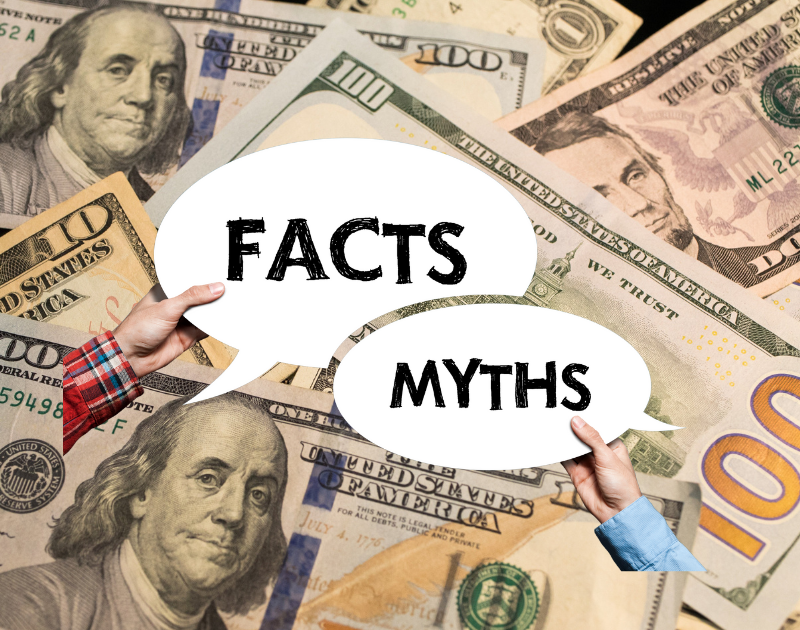Are you working harder but still feeling like you’re getting nowhere with your money? If so, you’re not alone. The financial world is filled with money myths that quietly sabotage your progress. It’s not just about how much you earn—it’s about understanding and rewriting the rules of the game.
In this post, we’ll bust five of the biggest money myths keeping you broke and show you how to break free. Let’s dive in.
Money Myth 1: “You Need a High Income to Get Rich”

This is one of the most pervasive myths about wealth. Many believe that a six-figure paycheck is the golden ticket to financial freedom. But as The Millionaire Next Door by Thomas Stanley reveals, most millionaires don’t have sky-high salaries.
The Reality:
Stanley’s research found that many millionaires work in ordinary professions like teaching, engineering, and small business management. Their secret? They live below their means, save diligently, and invest consistently.
Take this stat, for example: Nearly two-thirds of millionaires are self-made, and they prioritize habits like budgeting and investing over earning a high paycheck.
The Fix:
Focus on keeping what you earn. Here’s how:
- Create a budget to track and optimize your spending.
- Automate your savings to build wealth without constant effort.
Remember, wealth is built on discipline, not just dollars.
Money Myth 2: “You Need to Start With a Lot of Money to Invest”
This myth stops countless people from starting their investing journey. But as Benjamin Graham explains in The Intelligent Investor, starting small is not only okay—it’s smart.
The Reality:
The key to wealth is compounding. Here’s an example: Investing just $50 per month in an S&P 500 index fund can grow into $40,000 over 20 years, thanks to compounding returns.

Here’s a powerful stat to illustrate this: At an annual growth rate of 8%, an investment doubles every nine years. Time matters far more than the amount you start with.
The Fix:
Start today, no matter how small. Here’s how:
- Set up automatic contributions to an investment account.
- Choose low-cost index funds to maximize returns while minimizing fees.
- Remember: The earlier you start, the more your money can grow.
Money Myth 3: “You Have to Be a Finance Expert to Invest Successfully”
This myth feeds the false belief that investing is only for Wall Street pros. But Burton Malkiel’s A Random Walk Down Wall Street proves otherwise.
The Reality:
Malkiel’s research shows that fewer than 20% of actively managed funds outperform simple index funds over a 20-year period. Even professional fund managers struggle to beat the market consistently.

The chart illustrates the dramatic impact of even a small difference in annual returns (3%) over time, highlighting why minimizing fees and sticking with index funds often yields superior results.
$250 invested each month at 10% annual returns turns into $295,041.38 after 25 years. At just 7% annual returns, that $250 invested each month turns into just $189,747.11. That $105,294.27 difference shows why under-performance can really hurt in the long run.
The Fix:
- Avoid day-trading and stick to long-term strategies.
- Focus on matching the market, not beating it.
Money Myth 4: “Debt Is Always Bad”

We’re often told to avoid debt at all costs. But as Robert Kiyosaki explains in Rich Dad Poor Dad, debt can be a powerful tool when used strategically.
The Reality:
Kiyosaki distinguishes between good debt and bad debt:
- Good debt: Invested in assets like real estate that generate income.
- Bad debt: Spent on luxury items or consumer goods.
For example, Kiyosaki used good debt to buy a rental property with a $200,000 loan. The property generated enough rental income to cover the mortgage and expenses while still leaving a profit. Over time, the property appreciated in value, increasing his wealth.
The Fix:
Reframe your thinking about debt:
- Ask: “Will this debt make me money or cost me money?”
- Use debt strategically to invest in income-generating assets like real estate, businesses, or education.
Money Myth 5: “Millionaires Live Lavish Lifestyles”

Social media and pop culture love to show millionaires living extravagantly. But The Millionaire Next Door reveals a much different reality.
The Reality:
Most millionaires live modestly. For example:
- They drive practical cars like Toyota Camrys.
- They live in middle-class neighborhoods.
A key stat: 80% of millionaires are first-generation rich, meaning they built their wealth from scratch by prioritizing saving and investing over spending.
The Fix:
- Let go of the “keeping up with the Joneses” mentality.
- Focus on building financial independence, not appearances.
Wrapping It Up: How to Break Free from Money Myths
These five money myths can quietly sabotage your financial progress, but now you know how to break free. Here’s your game plan:
- Start small, stay consistent, and let compounding work its magic.
- Automate your savings and investments. Invest in low-cost index funds.
- Use debt strategically to grow wealth.
If you’re ready to dive deeper, check out these books for more insights:
- The Millionaire Next Door by Thomas Stanley
- The Intelligent Investor by Benjamin Graham
- A Random Walk Down Wall Street by Burton Malkiel
- Rich Dad Poor Dad by Robert Kiyosaki
Break free from the money myths, and start building the financial future you deserve.
